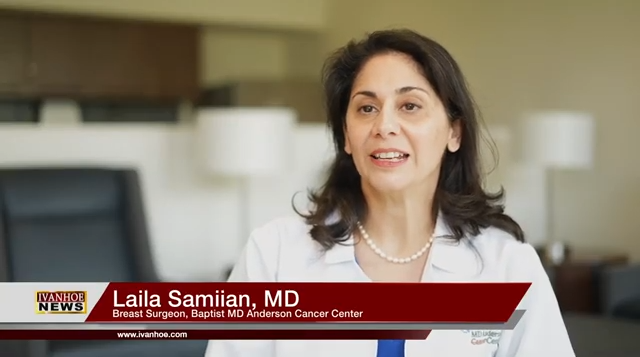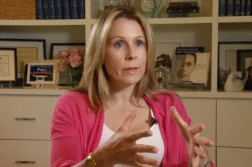Breast surgeon and director of the breast program at Baptist MD Anderson Cancer Center in Jacksonville, Florida, Laila Samiian, MD, FACS, talks about a new way to find breast cancer in dense breasts.
Interview conducted by Ivanhoe Broadcast News in 2023.
How common are dense breasts?
Samiian: About half of women have heterogeneously dense, or extremely dense breast tissue, which is harder to see through on mammograms. Some lesions or tumors can hide in the dense tissue and it may not show up as clearly on a mammogram when women have dense breasts.
Do your breast gets denser as you age?
Samiian: No, it’s the opposite. Your breast should decrease in density as you age or after you go through menopause because a lot of the dense glandular tissue that makes milk will shrink or involute and get replaced with more fatty tissue. That’s why mammograms are easier to see through in older women and those who are postmenopausal. Young women have more dense breast tissue so mammograms are not as accurate in younger women. Some women’s breasts, genetically, retain their density. So, they don’t involute their dense tissue as they get older and they maintain the dense breasts they’re born with. These women tend to be at higher risk for developing breast cancer.
Having dense breast can increase the risk of getting what?
Samiian: It can increase your risk for breast cancer and also increases your risk that the mammogram won’t pick up the breast cancer early on.
Why is that? What is dense breast made of? Why can’t mammogram pick that up?
Samiian: So, we have fatty tissue and then we have the glandular tissue that is the functional part of the breast that makes the milk, has lobules and ducts that make and carry the milk to the nipple. And some women are born with more of the dense glandular tissue and less of the fatty structure. So it’s genetic, and having more of that dense tissue means having more active tissue, which usually has the highest chance for developing breast cancer.
Now, you start off with the mammogram. If you have dense breast, then they move you to what?
Samiian: They notify you of how dense your breasts are. Most states have a dense breast notification law where they have to notify you if you have dense breast tissue and the fact that your mammogram may not be as sensitive in picking it up. So, supplemental imaging is usually covered by insurance if you have dense breast tissue, or if you’re high risk. So, all women need to have some risk assessment to determine what their chance is of developing breast cancer throughout their life. If they have more than a 20% lifetime risk for developing breast cancer, they’re considered high risk and can get a supplemental breast MRI once a year in addition to getting their yealy mammogram. If you’re not really high risk but you still have very dense breast tissue, one supplemental imaging options is ultrasound. And so Automated Whole Breast Ultrasound is an easy, additional screening tool to supplement your annual mammogram.
Now, you call that ABUS, right?
Samiian: Correct, ABUS.
So what is ABUS?
Samiian: It’s an Automated Whole Breast Ultrasound machine that can do a sonogram of your whole breast on each side. The procedure takes about 30 minutes, and most ultrasounds are done by a technologist by hand. We usually use it for a specific targeted area. A whole-breast ultrasound scans the whole breast, up and down to create a bunch of three-dimensional, high-definition images, which are then read by the radiologist. It’s a lot of images for them to go through. It requires compression and contact so the machine presses down on the breast and chest wall to capture those images.
So if you already know you have dense breast, you’re already in that 20%. Can you just go straight to ABUS?
Samiian: Just having dense breasts does not automatically confer a 20% lifetime risk. The ABUS supplements the mammogram, but does not replace it. There are things that the ultrasound will pick up that the mammogram won’t, and there are things that the mammogram will pick up that the ultrasound won’t. Mammograms can pick up calcifications and also they have to correlate them together anatomically. So, ABUS is really not an replacement for your mammogram, but it’s a really great complement to it. If your mammogram is negative, then you can get a supplemental whole breast ultrasound as an additional screening option. But if your mammogram shows an abnormality or if you feel a lump or have a symptom or a problem with your breast, then you really need a diagnostic ultrasound where they target the problem to figure out what the issue is.
How long has ABUS been around? How long have you been using it?
Samiian: I think it’s around for more than 10 years. It’s been in research trials and recently it’s becoming more standard across the country.
Now, I know probably the number one complaint of women with mammograms is: “If a man had to do this, they would come up with a better mammogram.” It’s uncomfortable, it’s painful. Is ABUS better? Any easier?
Samiian: I think it’s easier as far as you’re laying flat on your back and they put the device on your breast that scans it. But is still has to have compression and contact with the skin as it goes across it. It’s not good if you have a port, defibrillator, pacemaker or some implant in your chest because it can cause compression of that device or implant. It’s okay if you have breast implants. It’s just not good if you have a defibrillator or pacemaker.
Has this really changed mammogram and breast cancer diagnosis for you and for your patients?
Samiian: Well, I think it’s a good supplement to have for patients who may not be able to have a breast MRI. For example, if you have dense breast tissue and you’re pregnant they can do mammograms and shield the abdomen. But your breasts get even more dense during pregnancy and you’re lactatating, perhaps they could augment your imaging by adding the ultrasound to give you an extra layer of screening to identify a mass.
What’s the difference between the MRI and the ultrasound?
Samiian: MRI is magnetic resonance imaging. So it’s not radioactive, it doesn’t have radiation or X-rays. Instead they put in an IV so they can give you gadolinium contrast, which then goes into the breast tissue and retains in the tissue that has a lot of blood flow. Sometimes benign things can have blood flow, but it washes out in a normal pattern. However, cancers and tumors tend to have a lot of vasculature; they tend to be leaky, so the contrast flows in and lingers and stays in tumors. So it’s easier to identify these tumors on a breast MRI because they light up. There’s downsides to the breast MRI as it can also light up things that are not cancer because it’s very sensitive. So it can have false positives where you may find benign things but then you have to investigate it to prove that it’s benign.
Perfect. Anything we’re missing?
Samiian: So ultrasound it doesn’t require IV contrast and you lay on your back instead of on your stomach. It’s a little easier to perform, but the images have to be reviewed by a radiologist. There’s a lot of images, and the good thing is you can replicate it year to year, so they can compare from years past‑-same location, –year to year to see if something has changed or grown. There are caveats with ultrasound: an altrasound will tell you if there’s a solid mass or a cyst, but just because you see a solid mass doesn’t mean it’s all cancer. They have to look at the shape and blood flow and sometimes it might lead to additional imaging. So if something shows up as abnormal on a whole-breast ultrasound then you have to come back and for diagnostic imaging to determine if it’s suspicious enough for a biopsy. So it could pick up benign things as well.
Any breast cancer or mammogram myths you want to dispel, right now, that you just hear over and over and you want people to know?
Samiian: Well, in regard to mammograms, the main thing is if a woman feels a mass in her breast and her doctor examines her and confirms it and they go for a mammogram or ultrasound and it’s negative, it still requires follow up. I would definitely recommend that she follows up with a breast surgeon because not all cancers show up on a mammogram, and some cancers don’t show up on ultrasound right away but they might show up as the tumor gets bigger. So, if there is abnormality or lump in the breast, you’re not cleared just because your mammogram is negative. You need further examination by your doctor and you still need to see a breast specialist; sometimes we go ahead and do a biopsy or risk assessment and identify someone as high risk and then proceed with a breast MRI. Usually if your MRI, mammogram, ultrasound are all negative, the chance of missing a breast cancer is very low but definitely a breast specialist needs to evaluate that patient.
END OF INTERVIEW
This information is intended for additional research purposes only. It is not to be used as a prescription or advice from Ivanhoe Broadcast News, Inc. or any medical professional interviewed. Ivanhoe Broadcast News, Inc. assumes no responsibility for the depth or accuracy of physician statements. Procedures or medicines apply to different people and medical factors; always consult your physician on medical matters.
If you would like more information, please contact:
Emily Sharpe Wesley Roberts
Emily.sharpe@bmcjax.com Wesley.roberts@bmcjax.com
Sign up for a free weekly e-mail on Medical Breakthroughs called First to Know by clicking here




